Raahe 作者: 来源: 发布时间:2021-10-16
一、所属省或是州,具体位置,人口,面积
Raahe is a town and municipality of Finland. Founded by Swedish statesman and Governor General of Finland Count Per Brahe the Younger in 1649, it is one of 10 historic wooden towns (or town centers) remaining in Finland. Examples of other Finnish historic wooden towns are Kaskinen (Kaskö), Old Rauma, Porvoo (Borgå), Jakobstad (Pietarsaari), and Vaasa (Vasa). After a devastating fire in 1810, Raahe was rebuilt adhering to new design principles which minimized the risk of fire and enlarged some civic spaces. Old Raahe is noted for its Renaissance-inspired rectilinear town plan featuring an unusual central-square (called Pekkatori) with closed corners.
Raahe is located on the northern shores of the Gulf of Bothnia in the region of North Ostrobothnia. The municipality has a population of 24,803 (January 31, 2019) and covers an area of 1,889.00 square kilometres (729.35 sq mi) of which 870.77 km2 (336.21 sq mi) is water. The population density is 46.93/km2 (121.5/sq mi). Historically an agricultural and maritime region, Ostrobothnia supplied the largest number of immigrants from Finland to the US and other countries such as Canada and Australia during the great migration of the late 19th and early 20th centuries.
Founded as a Swedish-and-Finnish-speaking town, the municipality is now unilingually Finnish.
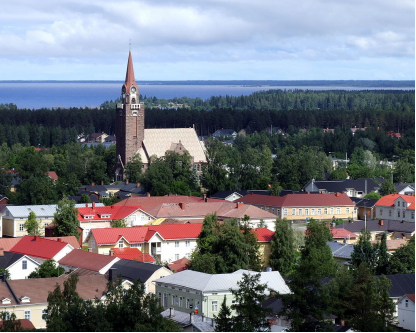
https://raahe.fi/
二、自然地理
1.地理条件
There are a large number of islands off Raahe. These are Akkualla, Iso-Kraaseli, Kalla, Clock, Konikari, Koninpää, Kumpele, Louekari, Maapauha, Pikku-Kraaseli, Preiskari, Pululärkki, Rääpäkkä, Rääpäkänriutta, Smitinriutta, Smitti, Pocket, Outdoors, Ämmä, Right in front of the city are Ulko-Fantti, Maa-Fantti and Musta. Much of the archipelago is part of the Natura 2000 network. The Natura 2000 network in Raahe also includes the bird water area between the Pattijoki and Olkijoki estuaries and the Pitkäisneva area, a wilderness type far inland, which specializes in the clear-water Pitkäislähde.
The bedrock of the area is variable. In the Long Strait and nearby islands, the bedrock is plagioclase porphyrite. Near the heart of the city, the bedrock is granite. In Lapaluuoto and Antinkangas, mica shingles and phyllites. There is amphibolite in the south. Archipelago is revealed by the surf, rocks. There are plenty of large boulders and bare cliffs on the Pattijoki border, e.g. Leather Rock and Jylhänkalliot. At Pattijoki, the bedrock on the coast is mica gneiss. Inland, the rock type changesgranite into gneiss and granite. There are also small areas of gabbro and diorite in the area of the former municipality of Vihanni. Lampinsaari has a zinc-bearing Malmio, which also contains copper, sulfur and lead.
The coast is a low plateau, but the terrain rises leisurely inland. The altitude range is variable, but even the highest points are usually 110 meters above sea level. On the south side of the Piehinkijoki, the landscape becomes a typical Ostrobothnian expanse.
The forests in the area are partly swampy spruce and pine forests. On the shores grow thick alder bushes and sea buckthorn. There are extensive coastal meadows on the shores, which include plant rarities on the Arctic coast, such as halibut and greenfish. The marshes of the region, Juttisuo, Peuraneva and Ispinäneva, Märsyneva, Kuuhkamonneva, Ahmaneva and partly Hirvineva coming to the Raahe region. Raahe is laughing are modest compared to the large rivers of Ostrobothnia.
2.交通情况
Raahe has been a major port city since its inception. Today, the Port of Raahe is the sixth busiest port in Finland, with about 700 ships calling there every year. Various raw materials and bulk cargoes, steel, sawn timber, containers and project-type shipping are transported through the port.
The municipalities of the Raahe region, Pyhäjoki, Raahe and Siikajoki, jointly manage public transport in the entire region. Public transport planning has taken into account the locations of the region residential areas young people and the elderly, and the region's educational institutions and public sector buildings. Local traffic is run in Raahe and regional traffic in other surrounding municipalities. In winter, about 110 bus services are run in the Raahe region and in summer 85. In winter, the county government's purchasing traffic accounts for about 36 per cent of regular traffic and in summer for about 53 per cent. To use public transport, it is possible to purchase a rechargeable card. Local traffic is operated by Käkelän Liikenne.
三、经济发展和规模
The municipal tax rate is 19.75%. In 2007, the structure of the economy was as follows: agriculture and forestry 1%, construction 6%, manufacturing 43%, and retail, services and public services 50%. The sub-region includes the municipalities of Pyhäjoki and Siikajoki.
With the metal economy, Raahe has grown from a migratory city to the third largest city in Oulu County after Oulu and Kajaani. Like Oulu, the city is currently striving to develop IT know-how in cooperation with companies in the metal industries (Steelpolis) and ICT industries (Softpolis) network, as well as companies belonging to the ProMetal competence center program.
In 2007, Raahe's job self-sufficiency was 114.4 per cent. Agriculture and forestry account for about one per cent of jobs, industry for 43 per cent, construction for six per cent and trade and other services and social services for 50 per cent.
https://raahe.fi/
四、产业特点/重点项目
Raahe was granted Staple port rights in 1791 and was traditionally a harbor town. With industrialization, Raahe was reinvented as a steel and heavy industry city and has further developed with engineering services, ICT and software production. Raahe is known for steel, heavy machinery, engineering works, shipping and ICT. The Rautaruukki steel mill, which up to the 1980s was the largest single industrial site in the Nordic countries, is located in Raahe. The mill produces steel plate, coil and sheeting and semi-finished products for the engineering works.
Traditionally, Raahe was a port city. In the late Age of Sail, the 1850s and on, shipping companies in Raahe owned Finland's largest fleet of sailing vessels, 60 in total at their height. Currently, the port of Raahe is the sixth busiest port in the country, with 700 ships visiting each year. Cargo that is transported through the port includes raw materials and loose cargo, steel, lumber, containers and contract-shipped goods.
With the steel industry, Raahe has grown into the third largest city in the ex-Oulu province, after Oulu and Kajaani. Like Oulu, the city promotes the ICT business, with the help of the steel industry (ProMetal and Steelpolis) and ICT industry (Softpolis) business incubators/business parks.
五、风景名胜,景点( attractions)
1. Raahe Museum
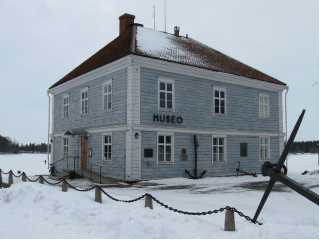
The Raahe Museum is a maritime museum founded by Carl Robert Ehrström in 1862, located near the center of Raahe on the shores of Pikkulahti. The museum moved to the beginning of the 1900s to its current location at the Raahe act as the Old Customs Warehouse building, which was completed in 1848. The museum is Finland 's oldest universities outside the museum.
In total, the museum's collections contain about 15,000 objects. Most of the artefacts date from the 19th century, when Raahe was a major shipowner city. The objects of that era are mostly souvenirs and necessities brought from distant lands by the crews of ships. The best known and most valuable of the museum’s artifacts was “Mr. Wanha,” the world’s oldest surviving diving suit. It is made of calfskin in the 18th century. Mr. Wanha is currently housed in the Raahe Crown Warehouse Museum.
2. Wanha Raahe
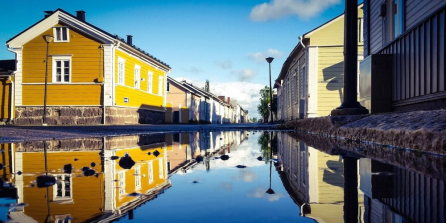
Wanha Raahe is one of the best preserved 19th century wooden towns in our country. Wanha Raahe is not a museum district, but a living district that tells its story of the stages of building and living in the city from centuries to the present day.
The city, built around the former home of Lapinukko, was initially modest. According to a station map drawn in 1659, the oldest surviving image of Raahe, the then ten-year-old city comprised only a dozen blocks, several of which were only small strips. Only two streets crossed longitudinally and three intersected transversely. The drawing shows that the city is surrounded by so-called customs; there were two customs gates: east at the intersection of the present Brahenkatu and Reiponkatu and south at the end of Pitkänkatu (now Kauppakatu) at approximately the present Koulukatu. The city’s already busy harbor at the time was Pakkahuoneen, now the Pakkahuone Museum, on the beach. There was no shortage of timber, stone was obtained e.g. from the islets of the archipelago. The city, founded by the Count, Governor-General Peter Brahe, at the behest of Queen Kristiina, rose like “by magic”.
https://www.visitraahe.fi/wanharaahe
3. Coffin Red Room
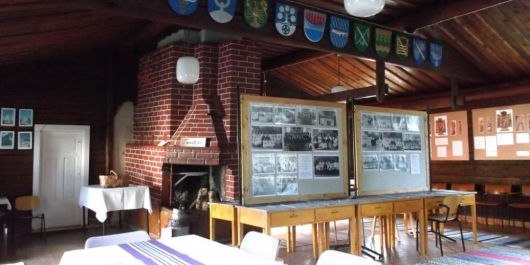
Punainen Tupa is located in the yard of the Arkkukari house, which used to be a municipal house and was originally built as a parsonage, next to the Saloisten Kotiseutumuseo. The cabin is currently owned by the Salo Homeland and Museum Association. In summer, Tuva has photo exhibitions and a summer café, and the museum's medieval exhibitions are also in Tuva. The room can also be booked for private events or come with a group to see exhibitions.
https://www.visitraahe.fi/wanharaahe
六、历史文化
1.历史
Count Per Brahe the Younger, the governor-general of Finland, gave a charter to the town of Salo in the year of 1649 with the purpose of constructing a town at Satamakangas, near the old harbour site. However, the harbour area had become so low that the future town was decided to be transferred. A new and better location was found further to the north, at the bay of Raahe. Having acquired the possession of the parish of Salo in 1652, Per Brahe renamed the town Brahestad or Raahe in Finnish.
The planning of the town for the purpose of building Raahe was given to the surveyor Claes Claesson. His town plan followed the ideals of the regular grid plan of the Renaissance. All of the streets of Raahe were of equal width of 20-21 cubits or 10–11 meters. The market square stood by Rantakatu and the Town Hall behind the square. At the northeast corner of the town stood the church and the schoolhouse. Six blocks were realized of the town plan, i.e. the area surrounded by present-day Koulukatu, Kirkkokatu, Saaristokatu and Rantakatu. The later expansion and changes of the town have held the ambitions of Claesson's town plan in respect until the beginning of the latest century.
The oldest picture still remaining of the town of Raahe, a seventeenth-century drawing, dates back to the year of 1659. It depicts the town as being surrounded by a so-called customs fence with two custom gates, the eastern one located outside of the crossroads of present-day Brahenkatu and Reiponkatu streets and the southern one at the end of Pitkäkatu street (present-day Kauppakatu street) approximately by present-day Koulukatu street. The busy harbour of the town was located on the shore by the customs warehouse, the present museum.
There were two public buildings in Raahe: a handsome, admirable, two-story town hall with a tower, and a wooden church, whose construction had already begun in 1651. The church was given a weather boarding already in 1684-1685. This is one of the earliest examples of boarding known in Finland.
The dwellings and houses were made from logs. As a rule, they were built close to the street facing plot boundary, the long side and the ridge of the roof parallel to the street. The unbuilt portion of the plot against the street was fitted up with a high, solid plank fence and a drive-in gate. The plots inside a block were not separated by fences. The average house usually consisted of one or two rooms, most of which were of the two-room cabin type. Almost every house in the drawing of Raahe has the most remarkable novelty of the seventeenth century, the chimney. At the same time it was still quite common to have whole towns and villages with chimneyless houses, especially in Eastern Finland. Considered from the point of view of architectural history, at the time of its foundation Raahe was a quite modern town. As far as is known today, no buildings exist from the seventeenth century.
2. 文化体育
The City of Raahe's Cultural Office aims to organize a diverse cultural offer and financially supports the associations operating in the city that organize their own cultural activities. The Cultural Office maintains the Gallery and, together with Raahe College, is responsible for arranging basic art education for children in terms of visual arts and crafts. In addition, it provides information on Raahe's cultural events and distributes brochures about the events, rents meeting rooms and borrows benches and a dance floor.
https://raahe.fi/
七、其他信息
Raahe has been known as a school town for more than a hundred years thanks to a teacher seminar, the Raahe Bourgeois and Trade School and the Lybecker School of Crafts. One of Finland's first lower secondary schools of information technology (computer science) was established on the premises of the teachers' seminar. The Raahe School of Computer Science included a technical school and a technical college. It was later merged with Oulu University of Applied Sciences. In 2005, there were 15 primary schools in Raahe with a total of 2,611 children and young people, and two special schools with 65 students.
https://fi.wikipedia.org/wiki/Raahe
八、联系方式
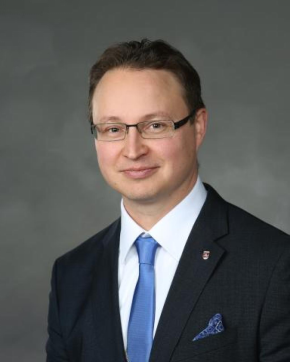
Mayor: Ari Nurkkala
Telephone: 08 439 3111
Email: kirjaamo@raahe.fi
https://raahe.fi/
